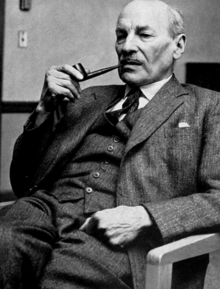Premiership of Clement Attlee
|
The Right Honourable The Earl Attlee KG OM CH PC FRS |
|
|---|---|
 |
|
| Prime Minister of the United Kingdom | |
|
In office 26 July 1945 – 26 October 1951 |
|
| Monarch | George VI |
| Deputy | Herbert Morrison |
| Preceded by | Winston Churchill |
| Succeeded by | Winston Churchill |
| Deputy Prime Minister of the United Kingdom | |
|
In office 19 February 1942 – 23 May 1945 |
|
| Prime Minister | Winston Churchill |
| Preceded by | Office created |
| Succeeded by | Herbert Morrison |
| Leader of the Opposition | |
|
In office 26 October 1951 – 25 November 1955 |
|
| Monarch |
George VI Elizabeth II |
| Prime Minister |
Winston Churchill Sir Anthony Eden |
| Preceded by | Winston Churchill |
| Succeeded by | Herbert Morrison |
|
In office 25 October 1935 – 11 May 1940 |
|
| Monarch |
George V Edward VIII George VI |
| Prime Minister |
Stanley Baldwin Neville Chamberlain |
| Preceded by | George Lansbury |
| Succeeded by | Hastings Lees-Smith |
| Leader of the Labour Party | |
|
In office 25 October 1935 – 7 December 1955 |
|
| Deputy |
Arthur Greenwood Herbert Morrison |
| Preceded by | George Lansbury |
| Succeeded by | Hugh Gaitskell |
| Deputy Leader of the Labour Party | |
|
In office 25 October 1932 – 25 October 1935 |
|
| Leader | George Lansbury |
| Preceded by | John Robert Clynes |
| Succeeded by | Arthur Greenwood |
| Lord President of the Council | |
|
In office 24 September 1943 – 23 May 1945 |
|
| Prime Minister | Winston Churchill |
| Preceded by | Sir John Anderson |
| Succeeded by | The Lord Woolton |
| Secretary of State for Dominion Affairs | |
|
In office 15 February 1942 – 24 September 1943 |
|
| Prime Minister | Winston Churchill |
| Preceded by | The Viscount Cranborne |
| Succeeded by | The Viscount Cranborne |
| Lord Privy Seal | |
|
In office 11 May 1940 – 15 February 1942 |
|
| Prime Minister | Winston Churchill |
| Preceded by | Sir Kingsley Wood |
| Succeeded by | Sir Stafford Cripps |
| Postmaster General | |
|
In office 13 March 1931 – 25 August 1931 |
|
| Prime Minister | Ramsay MacDonald |
| Preceded by | Hastings Lees-Smith |
| Succeeded by | William Ormsby-Gore |
| Chancellor of the Duchy of Lancaster | |
|
In office 23 May 1930 – 13 March 1931 |
|
| Prime Minister | Ramsay MacDonald |
| Preceded by | Sir Oswald Mosley |
| Succeeded by | The Lord Ponsonby |
| Under-Secretary of State for War | |
|
In office 23 January 1924 – 4 November 1924 |
|
| Prime Minister | Ramsay MacDonald |
| Preceded by | Wilfrid Ashley |
| Succeeded by | Richard Onslow |
|
Member of Parliament for Walthamstow West |
|
|
In office 23 February 1950 – 26 December 1955 |
|
| Preceded by | Valentine McEntee |
| Succeeded by | Edward Redhead |
|
Member of Parliament for Limehouse |
|
|
In office 15 November 1922 – 23 February 1950 |
|
| Preceded by | Sir William Pearce |
| Succeeded by | Constituency Abolished |
| Personal details | |
| Born |
Clement Richard Attlee 3 January 1883 Putney, Surrey, UK |
| Died | 8 October 1967 (aged 84) Westminster Hospital, London, UK |
| Resting place | Westminster Abbey |
| Nationality | British |
| Political party | Labour |
| Spouse(s) | Violet Millar (m. 1922; d. 1964) |
| Children |
|
| Parents | Henry Attlee Ellen Bravery Watson |
| Alma mater | University College, Oxford |
| Profession | Lawyer, Soldier |
| Military service | |
| Service/branch | British Army |
| Years of service | 1914–1919 |
| Rank | Major |
| Battles/wars | |
| Awards | |
Clement Richard Attlee, 1st Earl Attlee, KG, OM, CH, PC, FRS (3 January 1883 – 8 October 1967) was a British statesman of the Labour Party who served as Prime Minister of the United Kingdom from 1945 to 1951 and Leader of the Labour Party from 1935 to 1955. In 1940, Attlee took Labour into the wartime coalition government and served under Winston Churchill, becoming the first person to hold the office of Deputy Prime Minister of the United Kingdom. He went on to lead the Labour Party to an unexpected landslide victory at the 1945 general election; forming the first Labour majority government, and a mandate to implement its postwar reforms. The 12.0% national swing from the Conservatives to Labour was unprecedented at that time and remains the largest ever achieved by any party at a general election in British electoral history. He was re-elected with a narrow majority at the 1950 general election. In the following year, Attlee called a snap general election, hoping to increase his parliamentary majority. However, he was narrowly defeated by the Conservatives under the leadership of Winston Churchill, despite winning the most votes of any political party in any general election in British political history until the Conservative Party's fourth consecutive victory in 1992. Attlee remains the longest-ever serving Leader of the Labour Party.
...
Wikipedia
